55 years later: iconic IBM System / 360 mainframe cult consoles
- Transfer
As Wikipedia says: IBM System / 360 (S / 360) is the innovative generation of mainframe computers that was announced on April 7, 1964. System / 360 product development was an extremely risky project for IBM, because the cost of its implementation exceeded $ 5 billion (at today's prices, the cost of developing the first family of compatible computers was approximately 30 billion). Despite the fact that the project faced serious problems related to software, it was a huge success and rightfully entered the top three absolute winners in the nomination “Best Business Achievement of All Time”. System / 360 has set the direction of the entire computer industry for decades to come; all technologies come from here - bytes, 32-bit words, microcode, and standardized interfaces.
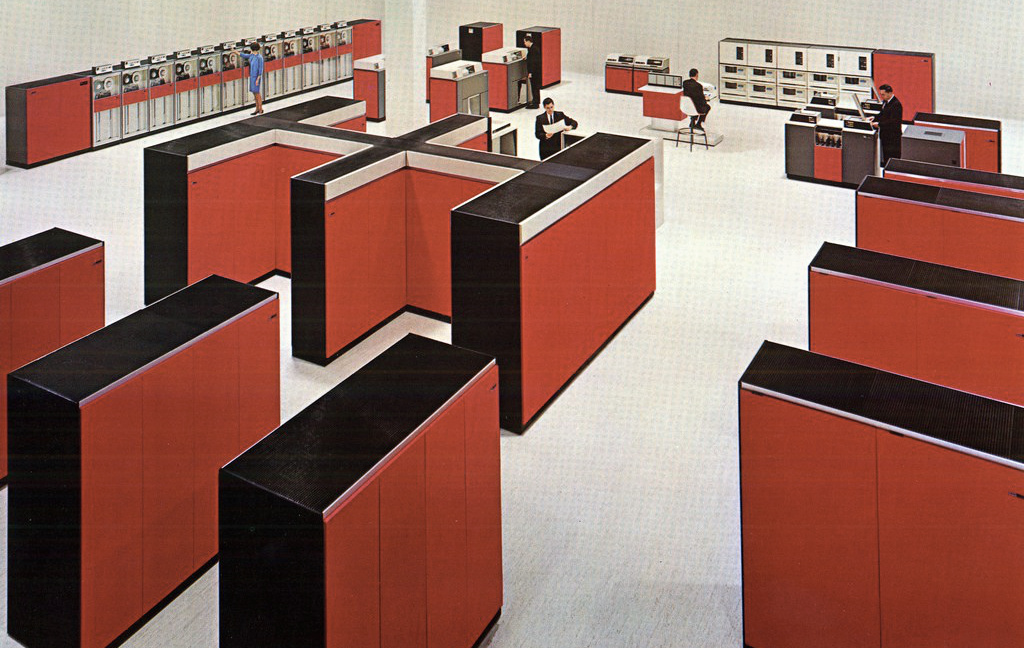
Before the advent of System / 360, IBM (like most computer manufacturers) produced a line of computers with completely incompatible architecture, while System / 360 was a family of software-compatible mainframes with a common architecture. The fastest model in the original lineup was 50 times more powerful than the slowest, but they could all run the same software. Now, customers were offered a line of several computers that differ in speed and cost, but at the same time using the same set of commands. The Universal System / 360 System is a fully software-compatible computer. The system worked with scientific and business applications, its name is also symbolic - 360 degrees, which cover the entire spectrum of possible applications. "
Although the S / 360 models had a common architecture, internally they were completely different from each other in order to occupy different market niches depending on cost and performance. Older models used less efficient hardware and an 8-bit data channel, while newer models used functions such as a wide data channel, high-speed, non-volatile memory registers, and machine instructions that were not executed in the native code and caching. To all, the front of the computer also differed: different LEDs and switches.
This article describes the various S / 360 models, and how to identify them from the front panel. I'll start with Model 30, a popular budget system, and then go through the rest in order. Rationality and convenience are the main components of the principle by which computers receive their numbers. Along with memory capacity and performance, the model number also increased, from the simple but popular Model 20 to the high-performance Model 195.
The photo below shows Model 30, one of the low-cost S / 360 machines, with magnetic core memory sizes ranging from 8 to 64 kilobytes. The processor case was 1.524 m high, 76.2 cm wide and 1.73 m deep, the mass was 771 kg. What can I say, the car is huge by modern standards, but at that time this size was considered more than compact. System / 360 computers were built from modules called Solid Logic Technology (SLT), which contained several transistors and resistors, not as dense as integrated circuits. Although the Model 30 was the least powerful in the System / 360 lineup, it was very popular and profitable; its $ 8,000 / month rental brought IBM $ 1 billion in revenue by 1972.

You may wonder why these computers are equipped with such complex consoles. There were three main functions of using the console. The first function is for the basic tasks of “managing the hardware complex”, such as turning on the system, loading it or turning it off using the controls (shown below). These controls were the only ones the operator needed in a sequential order on the S / 360 panel. Using the three hex switch dials, you could select an I / O module that contained boot software. After booting the system, the operator usually entered commands into the system without the help of the console.

The second console function is the presence (affixing) of the control operator. Debugging the program, monitoring the status of processor registers and RAM modules, as well as setting breakpoints (breakpoints, checking and debugging of program code). The Model 30 console controls below were used to put the operator in mind. To display the contents of the memory, the operator selected the address on the four hexadecimal switches on the left and pressed the “Display” button (left), entering data on the indicators on the dials of the switches. To make changes in the memory, the operator entered a 1-byte command using the two hexadecimal switch dials on the right and clicked the “Save” button. (Although Model 30 had a 32-bit architecture, it transmitted a command of 1 byte at a time, sacrificing speed at the expense of lower cost). Using the “Address Compare” switch, a breakpoint was set in the upper right corner.
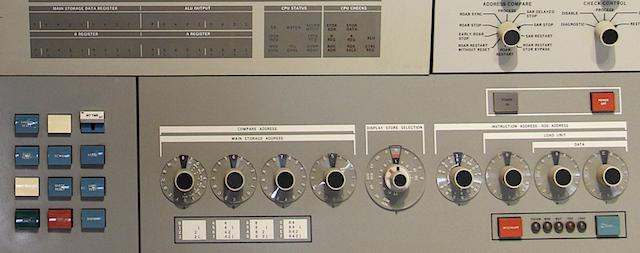
The third function of the console is system support and maintenance, which were performed by an IBM engineer. Such displays occupied most of the console, they displayed detailed information that provides access to the complex internal device of the computer. On the Model 30 console above, there was a large switch in the middle of the “Display Store Selection”, with it you could select any of the internal registers for display or modification. A number of indicators (in the image below) show the performance of micro-operations from ROM and operations on the input / output channel. (The rows of lights below showed the microcode instruction being executed from "read only storage" and operations on the I / O channel.)
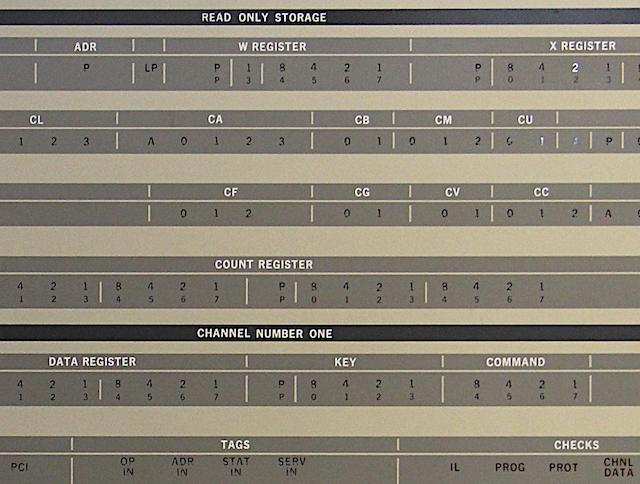 A closeup of the IBM S / 360 Model 30 console showing indicators for the microcode (ROM) and I / O channel. These registers were used in the middle of the system and were not visible to the programmer.
A closeup of the IBM S / 360 Model 30 console showing indicators for the microcode (ROM) and I / O channel. These registers were used in the middle of the system and were not visible to the programmer.
On the console there were meters of consumed electricity under the handle of the emergency power off. IBM's standard rental price was only 40 hours per week, and the customer was billed additionally for excessive energy consumption. If the system required repair, customers did not pay for downtime. An IBM engineer turned the switch with a key, as a result of which time was measured by a lower “service” counter instead of a “customer use” counter.
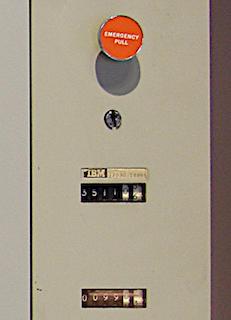
Let's move on to the end of the S / 360 family: Model 20 was designed for business applications. The memory capacity was limited, only 4KB - 32KB, the computer was extremely slow even by the standards of the 1960s, only about 5700 addition operations per second were performed. But on the other hand, such a processor was enough to generate business reports from punch cards, a card reader read 8 cards per second. Pursuing the goal of cost reduction, a subset of S / 360 commands were implemented in Model 20, and half size 8 registers were used, which makes Model 20 incompatible with the rest of the S / 360 line. Despite its limitations, the Model 20 was the most popular model of the S / 360 family due to its low price: by the end of 1970, more than 7400 cars were in operation. The monthly rental price of Model 20 started at $ 1,280.
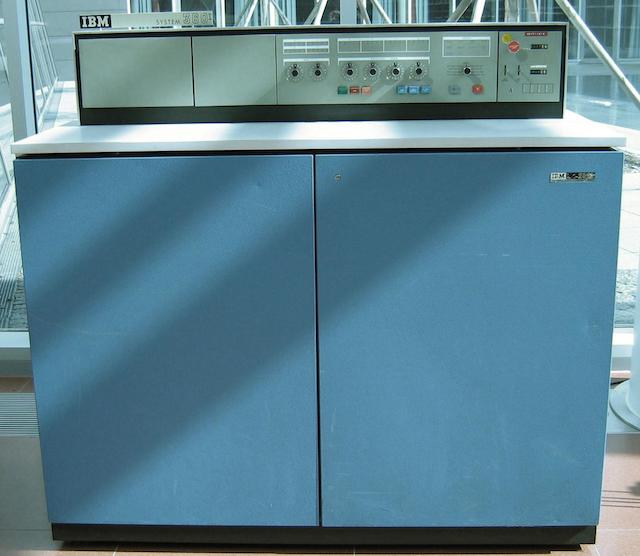
Using the small Model 20 console (image above), the operator turned on and off the computer, launched the program, etc. A few lines on the display showed the contents of the computer registers and, using switches with hexadecimal dials, the operator loaded data of 1 byte size (two switches on the left) into the memory address (next four switches). Using another controller, the operator debugged the program by changing the value in memory, setting breakpoints, step-by-step execution of the program. The emergency power off switch and usage counters were on the right.
In Model 20, the control panel for engineers is hidden under the cover (bottom). This panel provides additional controls and indicators for diagnostics and access to microcode. Since the Model 20 was simpler, the engineer did not need to display such a volume of information as in the Model 30.
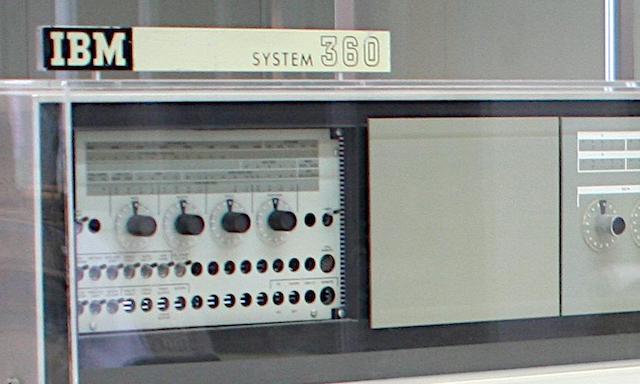
Model 22 is a stripped-down version of Model 30 at a price lower by 1/3, while providing performance about 5 times higher than Model 20. It was the last S / 360 family computer introduced in 1971. IBM said Model 22 is a "compromise in performance and price for small systems."
The basic equipment of Model 22 was leased for $ 850 per month (less than for Model 25 or Model 20), the purchase price ranged from 32,000 to 44,000 dollars. The standard configuration with three drives, an output for the printer and a card reader was much more expensive: the rent was about $ 5,600, and the acquisition was $ 246,000. Such a station weighed 680 kg and was the size of two refrigerators. Unlike Model 20, Model 22 was compatible with other products with part of the S / 360 line.

As for the console in Model 22, it was very similar to the one in Model 30. However, the Model 22 console had fewer rows with LEDs, and the indicators appeared on the console, and were not “recessed” as in Model 30 (flat cover ) Model 22 has a semiconductor memory device, not magnetic core memory.
Another budget system was Model 25. The system was designed to be cheaper than Model 30, and at the same time be compatible with other systems in the line. The base Model 25 could be rented for $ 5,330 a month, but it could be bought for $ 253,000. She was introduced in 1968.
Model 25 was a compact system, I / O controllers were located in the main unit (unlike other S / 360 systems). Unlike other budget systems, the system had a two-byte data channel for higher performance. One of the features of the Model 25 was a small convenient console; on Model 25, many operations used a console typewriter rather than a control panel. In the figure below, note that the control panel is about 2/3 lower than the black computer module behind it. The switches on the control panel are used to perform several functions (addressing and data), which makes it more compact than the panel in Model 30.
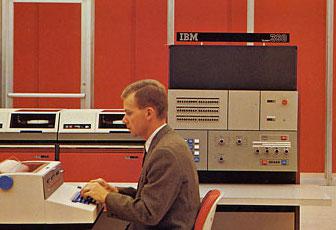
The Model 40 was a popular mid-range model, more powerful than the Model 30. Its rental cost from $ 9 to $ 17,000 a month, and by 1972 IBM brought a billion dollars in revenue. To improve performance, Model 40 used a two-byte data channel (unlike Model 30, which processed data one byte at a time).
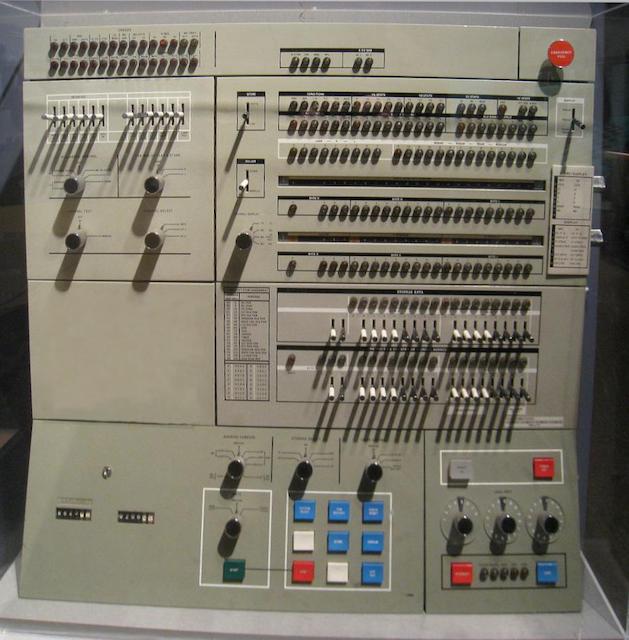
The photo above shows that the Model 40 console is much more complicated than the Model 30 console, this indicates the increased complexity of the "internal filling", that is, the hardware components of the system. Like other models, she had three switches with hexadecimal dials in the lower right corner, which they served to boot the system. But instead of switches with hexadecimal dials for entering the address and data, Model 40 had toggle switches: one for the address and one for the data.
The Model 40 used two tuning knobs, which allowed each row with LEDs to display eight different functions. Each such switch had an 8-position knob on the right side of the console: it was possible to select a specific register or display.
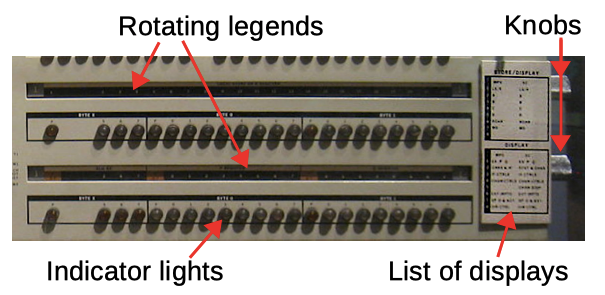
IBM's competitors in the scientific computing market have begun offering cheaper, faster systems designed specifically for numerical computing. To solve this problem, IBM created Model 44 for scientific computing, its main purpose is to quickly perform operations on floating point numbers and operations to collect information; 19 instructions for performing business-oriented tasks were excluded (instructions for performing arithmetic operations on decimal numbers and variable-length fields). These changes made Model 44 somewhat incompatible with the rest of the S / 360 family, although they added 30-60% faster performance compared to the more expensive Model 50. Despite the improved features, Model 44 was not a huge success for users.
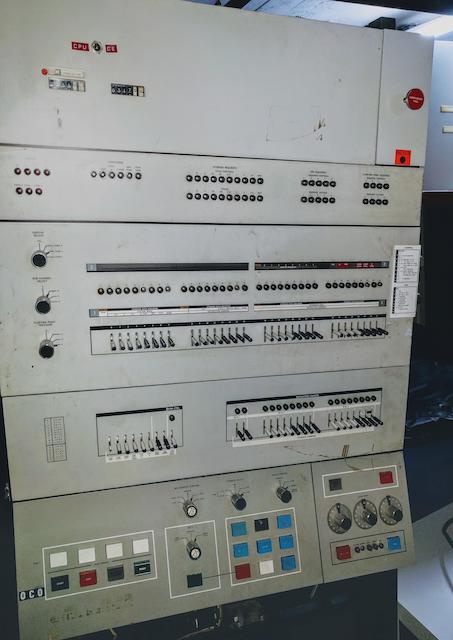
The Model 44 control console was similar in appearance to the Model 40 console with toggle switches and two rollers, but with Model 44 one of the rollers took over the functions of the toggle switches. And the internal content of the two computers was completely different; for higher performance in Model 44, instead of microcode, the control system was implemented at the hardware level. A four-byte data transfer channel was also used, which accordingly allowed moving data twice as fast as that of Model 40, which is why more indicators and switches were placed in each row on the console (32 data bits + 4 parity bits).
One of the features of the Model 44 console can be considered a rotary switch to select the accuracy of floating point numbers (to select floating point precision), a decrease in accuracy increases the processing speed. Another feature unique to Model 44 was the drive built into the side of the computer. Used disk cartridges with a capacity of 1MB. Using the button in the lower left corner of the console, you could control the drive.
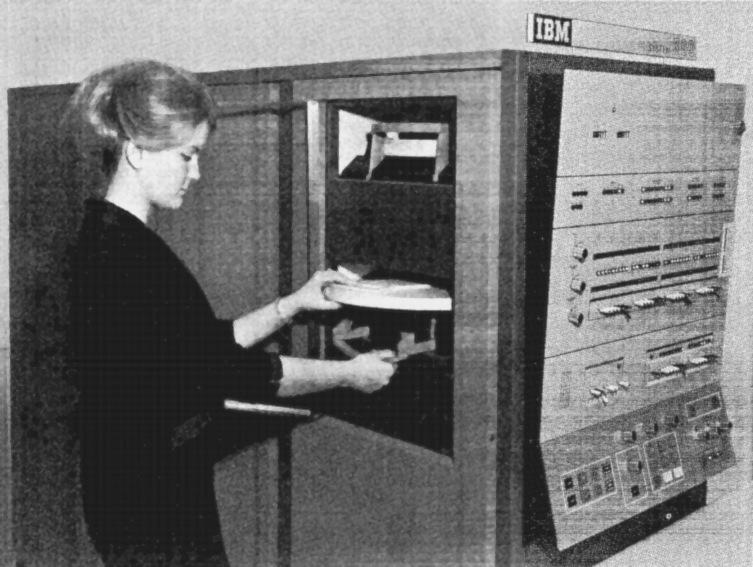
The Model 50 was significantly more productive than the Model 40, in part because it used a four-byte data channel. And the Model 50 was much larger than the younger models: a central processor of 5 blocks with 512 KB of memory weighed more than 3 tons. Model 50 could be rented for 18,000 - 32,000 dollars a month. The computer could be expanded by another 8 megabytes; each IBM 2361 Large Capacity Storage module contained 2 megabytes of RAM and weighed a ton.
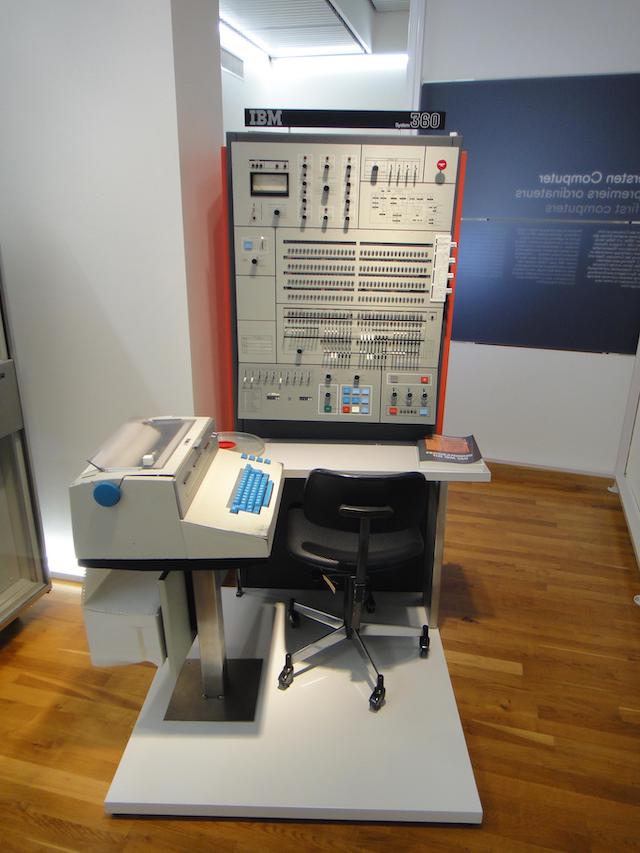
The Model 50 control console was more complex than Model 40 or 44. Like Model 44, toggle switches and indicators had 32 bits + parity due to a 4-byte data channel. The voltmeter and voltage regulators in the upper left corner were used by an IBM engineer during a routine check. By raising and lowering voltage levels by about 5% and checking for malfunctions, it was possible to detect malfunctions and replace components even before they fail.
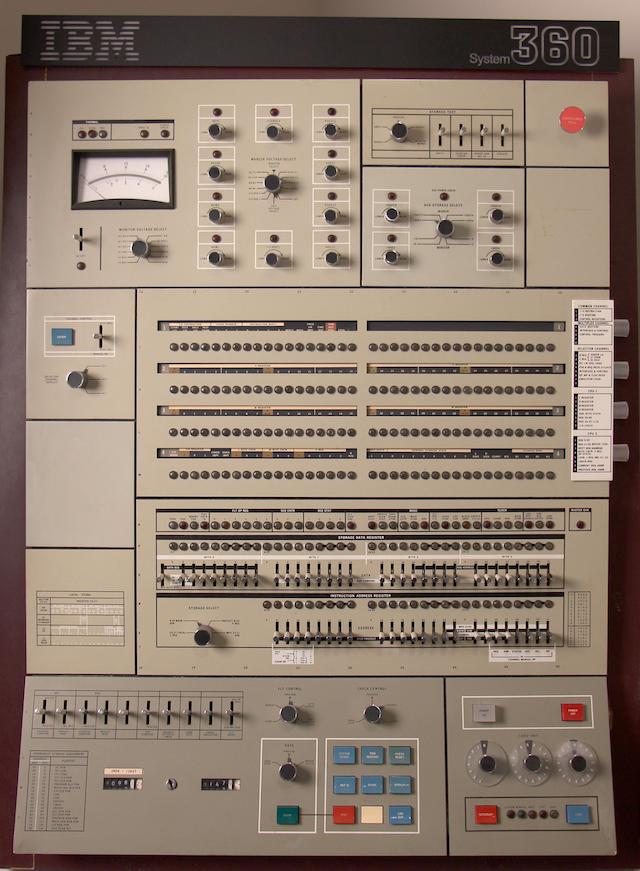
Models of the 60 series were similar, and were intended for computing in enterprises, scientific calculations. Although the Model 60 and 62 computers were announced at the launch of the S / 360 family, they were never put into production. Competitors announced the release of faster machines, after which IBM made improvements to RAM - this is how Model 65 came about. High-speed memory - 75 microseconds, and this replaced Model 60 (2 microseconds) and Model 62 (1 microseconds) even before they were released “in mass. "Model 65 could be rented for $ 50,000 a month.
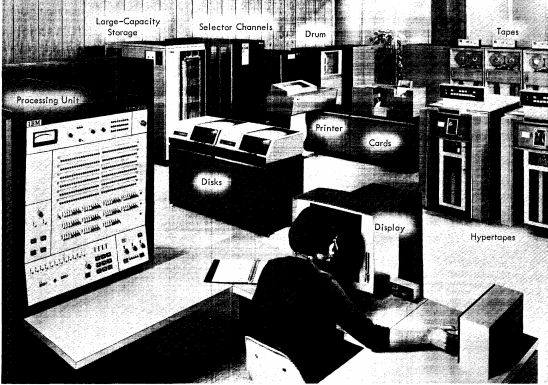
The Model 65 control panel had much in common with the Model 50 console, but there were 6 control knobs instead of 4 (on the right). Model 60 and above used an eight-bit data bus and fragment storage for maximum performance. To support a wide data transfer band, the control console had two rows of data toggle switches, as well as an address toggle switch to cover a wide range of addresses. Each tuning knob of 6 operated with 36 LEDs (4 bytes + parity), so 64-bit registers were divided into two rows.
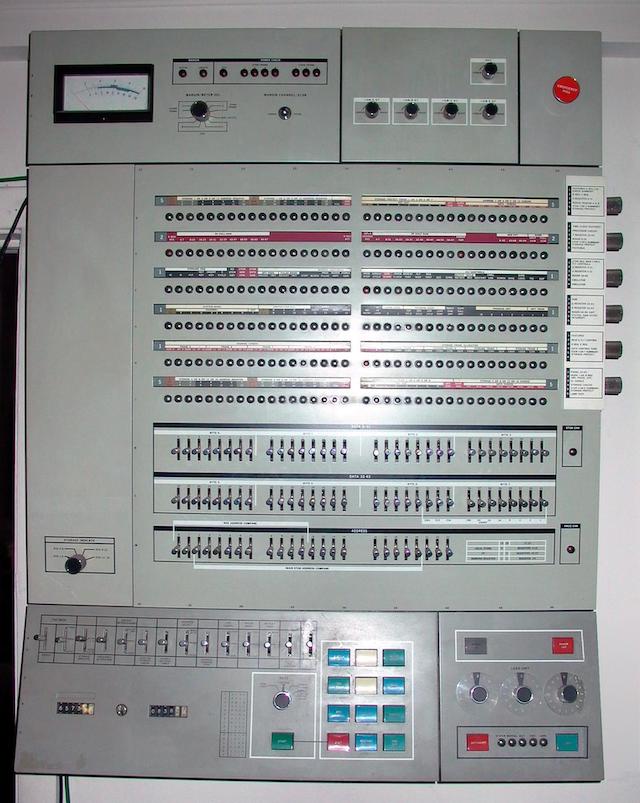
Model 67 was announced in 1965 and entered the market already in 1966, its goal was to satisfy the emerging demand for time-sharing systems. (Most computers at that time were with an OS that provided batch processing of tasks). Model 67 was, in essence, Model 65 with the addition of virtual memory called dynamic address translation. It supported real-time and online computing with remote users, time sharing, and simultaneous use of multiple users. Unfortunately, due to delays in the release of the operating system, Model 67 did not become popular, by the end of 1970, only 52 stations were installed.
Models of the 60th series were dimensional stations, with several connected memory modules. They could be configured as a duplex multiprocessor system, weighing more than four tons and occupying about 37 square meters; Pay attention to the presence of two consoles in the photo below.
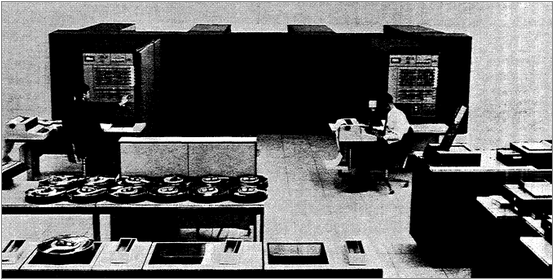
The high-performance Model 70 was announced in April 1964, but, as with the Model 60, it was replaced with a faster Model 75 even before deliveries began. The Model 75 console was much larger than the previous models, with a large number of LEDs. Why is that? For two reasons. Firstly, the internal architecture of the Model 75 was complex. Secondly, instead of using the knobs to display all the functions on the Model 75, everything was displayed using a variety of LEDs.
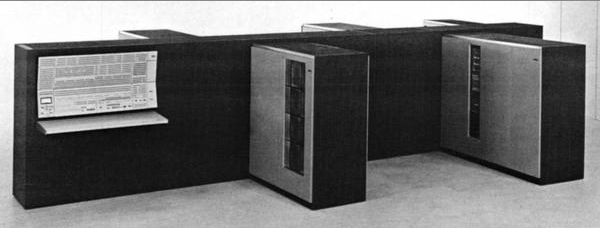
I would like to draw attention to the main components of the control panel. Devices providing operator interaction with the station (system start-up) were located in the lower right corner (section N), next to the consumed electricity meters (P). To check and modify the memory, the operator had at its disposal addressing switches ®, 64 data switches (M) and indicators (M). Other sections of the control panel were for IBM engineers. A voltmeter (K) was used for routine checks. Data bus control (A), high-speed storage device (B), variable (size) field instructions ©, control commands (E) and registers (F, L).
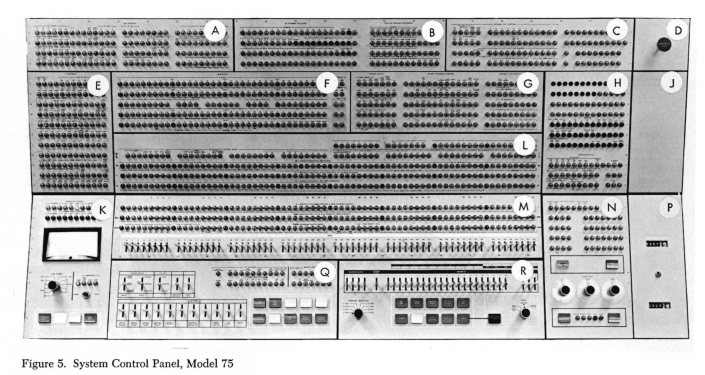
The rental price of Model 75 ranged from 50,000 to 80,000 US dollars, and the purchase price from 2.2 to 3.5 million US dollars. Model 75 performance was 1 MIPS, the computer executed about 1 million instructions per second. (Its performance was slightly lower than that of Intel 80286, which was approximately 1/10000 of the performance of modern Intel Core I7).
The high-performance Model 85 of the S / 360 line was introduced in 1968. Its weighty processor consisted of a dozen racks and weighed about 7 tons, as shown in the photograph at the beginning of the article. A key innovation in Model 85: cache with faster access speed. The Model 85 was the first commercial cache computer. This is the first IBM computer to use integrated circuits with a medium level of integration (IBM called them Monolithic System Technology or MST). Unfortunately, the system was not successful with customers due to the high price. A total of 30 Model 85 stations were released.
There was a radically different approach to the construction of the Model 85 control panel. The console was small compared to others in the S / 360 line, it had fewer LEDs and indicators. Most operator functions were now performed by a cathode ray tube display and keyboard. The “indicator viewer” located to the left of the operator has replaced most of the LEDs on the control panel. In it, 240 LEDs were combined with a mic-projector, which showed certain labels depending on the configuration. It was a more advanced version of the tuning knob - the equivalent of 2,400 individual LEDs. Accordingly, the system also included a microfiche viewer, now the folders with maintenance documentation were replaced with compact cards.
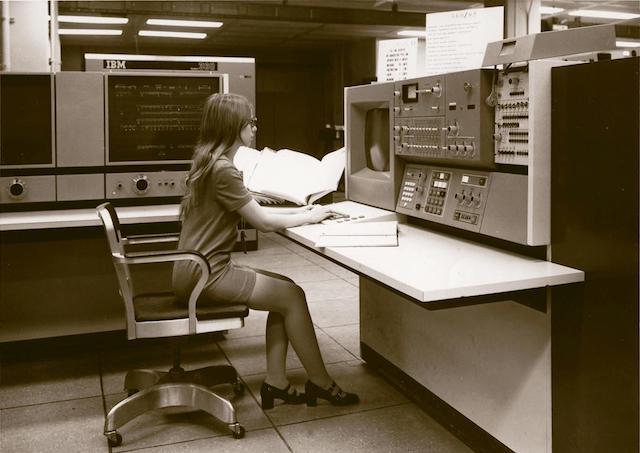
Model 90 was just the prototype of a brand new supercomputer. An improved Model 92 was announced a few months later, and as a result, a less productive Model 91 system was developed, which was supposed to compete with the CDC 6600 supercomputer (developed by Cray). Model 91 entered the market in 1967, about two years after the CDC 6600, but it never won. Only 15-20 pieces were released, even a price reduction to $ 6,000,000 did not change the situation, popularity did not come. In comparison, CDC has released more than 200 6000-series computers.
Model 91 was characterized by an advanced architecture: channels with high bandwidth, command execution with the ability to change the order. The system was a multifunctional module. The sophisticated architecture of the Model 91 required a large control panel filled with a multitude of LEDs and switches. The lower part of the console was equipped with the “operator presence” function, there were tumblers for 24-bit addressing of 8 bytes of data. The remaining indicators were needed by IBM engineers, they showed detailed information about the status of the system. The main operator controls (power, boot) were not on the main console, but on a small panel from the bottom right. The operator used a CRT (cathode ray tube display) for many tasks.
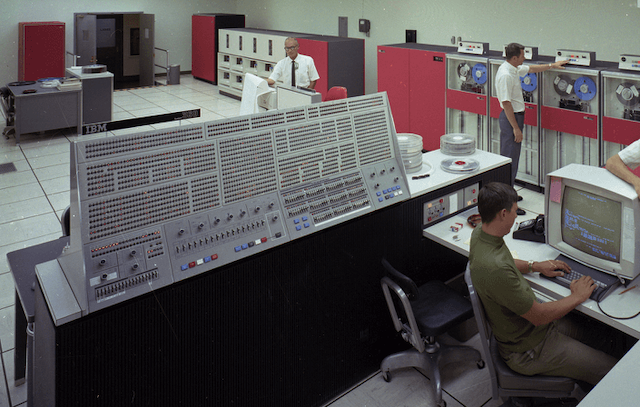
Model 91 required a separate room, only the central processor consisted of seven stand-alone modules: the CPU itself, three power supplies (not including the motor-generator set), a modular power distribution cabinet, a cooling medium distribution cabinet, and a console. In addition, the system had a memory control unit, as well as input / output devices. Model 91 was the first IBM system to use semiconductor memory in its small piece of “protected memory”, but not in main memory.
In 1951, IBM began to research storage devices on thin magnetic films as a replacement for memory on magnetic cores, and after many years of difficulties, in 1968, Model 95 made this replacement (otherwise everything was the same as in Model 91). Although it was the fastest memory of those times, IBM sold just two Model 95 units (NASA), and then abandoned thin-film storage devices.
Model 195 was "designed for high-speed computer applications." It was a reimplementation of Model 91 using integrated circuits (called the “monolithic integrated circuit”), with 32K cache. The rent ranged from 165,000 to 275,000 dollars per month, the purchase price - from 7 to 12.5 million dollars. The performance of the Model 195 was comparable to the performance of the CDC 7600 supercomputer, but, as with the Model 91, it appeared two years later than the CDC machine, and this mainly affected sales.
The model 195 console (below) was similar to the Model 95 control panel. As with the Model 91, a CRT was used for many operator tasks, there was also a separate small operator console (not shown in the photo).
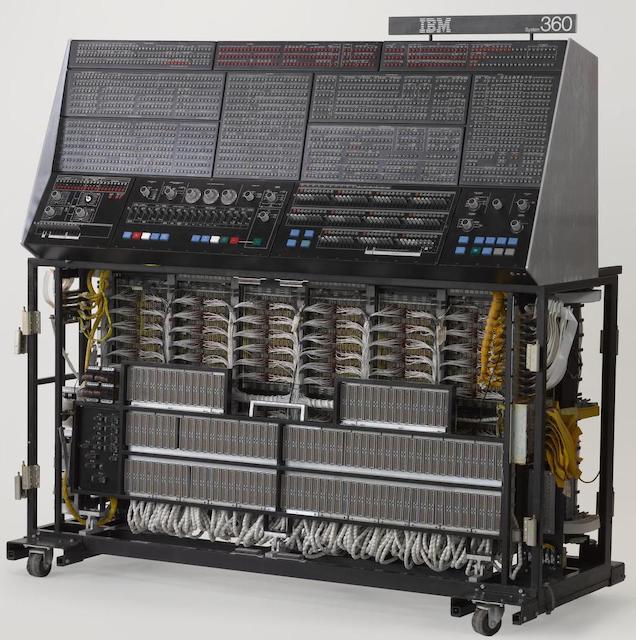
It is sometimes difficult to distinguish between the console models 30, 40, 50 and 65. The diagram below shows the main functions by which they can be distinguished. The Model 30 console was a flat surface without separate indicators and toggle switches. It can be recognized by 9 switches with dials at the bottom and a group of four settings knobs on the right. The Model 40 console had two knobs, and a group of four dial switches were located on the left. The Model 50 control panel had four tuning knobs and a voltmeter next to a dozen switches. The Model 60 had six tuning knobs and a voltmeter with a pair of switches.
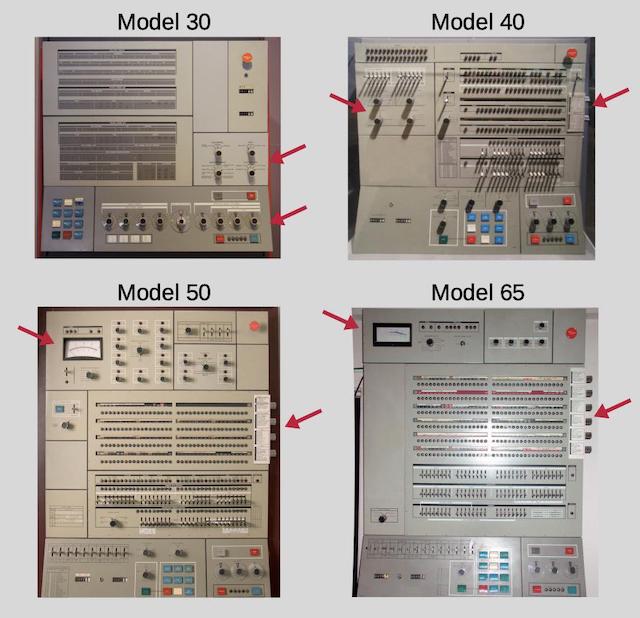
By modern standards, System / 360 computers were not particularly impressive in terms of performance: the Model 20 was slow with no more memory than the VIC-20 home computer (1980), while the Model 195 was comparable to the Macintosh IIFX (1990 ), which is approximately 1/1000 of the computing power of the iPhone X. Despite their low productivity, they were used by large companies, with their help they planned a flight to the moon and controlled the air traffic of the country.
Thank you for staying with us. Do you like our articles? Want to see more interesting materials? Support us by placing an order or recommending it to your friends, a 30% discount for Habr users on a unique analogue of entry-level servers that was invented by us for you:The whole truth about VPS (KVM) E5-2650 v4 (6 Cores) 10GB DDR4 240GB SSD 1Gbps from $ 20 or how to divide the server correctly? (options are available with RAID1 and RAID10, up to 24 cores and up to 40GB DDR4).
VPS (KVM) E5-2650 v4 (6 Cores) 10GB DDR4 240GB SSD 1Gbps until the summer for free when paying for a period of six months, you can order here .
Dell R730xd 2 times cheaper? Only we have 2 x Intel TetraDeca-Core Xeon 2x E5-2697v3 2.6GHz 14C 64GB DDR4 4x960GB SSD 1Gbps 100 TV from $ 199 in the Netherlands! Dell R420 - 2x E5-2430 2.2Ghz 6C 128GB DDR3 2x960GB SSD 1Gbps 100TB - from $ 99! Read about How to Build Infrastructure Bldg. class using Dell R730xd E5-2650 v4 servers costing 9,000 euros for a penny?

Before the advent of System / 360, IBM (like most computer manufacturers) produced a line of computers with completely incompatible architecture, while System / 360 was a family of software-compatible mainframes with a common architecture. The fastest model in the original lineup was 50 times more powerful than the slowest, but they could all run the same software. Now, customers were offered a line of several computers that differ in speed and cost, but at the same time using the same set of commands. The Universal System / 360 System is a fully software-compatible computer. The system worked with scientific and business applications, its name is also symbolic - 360 degrees, which cover the entire spectrum of possible applications. "
Although the S / 360 models had a common architecture, internally they were completely different from each other in order to occupy different market niches depending on cost and performance. Older models used less efficient hardware and an 8-bit data channel, while newer models used functions such as a wide data channel, high-speed, non-volatile memory registers, and machine instructions that were not executed in the native code and caching. To all, the front of the computer also differed: different LEDs and switches.
This article describes the various S / 360 models, and how to identify them from the front panel. I'll start with Model 30, a popular budget system, and then go through the rest in order. Rationality and convenience are the main components of the principle by which computers receive their numbers. Along with memory capacity and performance, the model number also increased, from the simple but popular Model 20 to the high-performance Model 195.
IBM System / 360 Model 30
The photo below shows Model 30, one of the low-cost S / 360 machines, with magnetic core memory sizes ranging from 8 to 64 kilobytes. The processor case was 1.524 m high, 76.2 cm wide and 1.73 m deep, the mass was 771 kg. What can I say, the car is huge by modern standards, but at that time this size was considered more than compact. System / 360 computers were built from modules called Solid Logic Technology (SLT), which contained several transistors and resistors, not as dense as integrated circuits. Although the Model 30 was the least powerful in the System / 360 lineup, it was very popular and profitable; its $ 8,000 / month rental brought IBM $ 1 billion in revenue by 1972.
Solid Logic Technology (SLT) - a hybrid technology for composing microelectronic circuits based on insulated flat, glass-encapsulated transistors and diodes, with shielded ceramic-based resistors. It was introduced by the company in 1964 along with the new IBM System / 360 mainframe. STL has replaced the pre-existing Standard Modular System (SMS).
By the standards of 1960, SLT was a revolutionary technology and contributed to the success of the System / 360 mainframe family in the 60s.

You may wonder why these computers are equipped with such complex consoles. There were three main functions of using the console. The first function is for the basic tasks of “managing the hardware complex”, such as turning on the system, loading it or turning it off using the controls (shown below). These controls were the only ones the operator needed in a sequential order on the S / 360 panel. Using the three hex switch dials, you could select an I / O module that contained boot software. After booting the system, the operator usually entered commands into the system without the help of the console.

The second console function is the presence (affixing) of the control operator. Debugging the program, monitoring the status of processor registers and RAM modules, as well as setting breakpoints (breakpoints, checking and debugging of program code). The Model 30 console controls below were used to put the operator in mind. To display the contents of the memory, the operator selected the address on the four hexadecimal switches on the left and pressed the “Display” button (left), entering data on the indicators on the dials of the switches. To make changes in the memory, the operator entered a 1-byte command using the two hexadecimal switch dials on the right and clicked the “Save” button. (Although Model 30 had a 32-bit architecture, it transmitted a command of 1 byte at a time, sacrificing speed at the expense of lower cost). Using the “Address Compare” switch, a breakpoint was set in the upper right corner.

The third function of the console is system support and maintenance, which were performed by an IBM engineer. Such displays occupied most of the console, they displayed detailed information that provides access to the complex internal device of the computer. On the Model 30 console above, there was a large switch in the middle of the “Display Store Selection”, with it you could select any of the internal registers for display or modification. A number of indicators (in the image below) show the performance of micro-operations from ROM and operations on the input / output channel. (The rows of lights below showed the microcode instruction being executed from "read only storage" and operations on the I / O channel.)
 A closeup of the IBM S / 360 Model 30 console showing indicators for the microcode (ROM) and I / O channel. These registers were used in the middle of the system and were not visible to the programmer.
A closeup of the IBM S / 360 Model 30 console showing indicators for the microcode (ROM) and I / O channel. These registers were used in the middle of the system and were not visible to the programmer.On the console there were meters of consumed electricity under the handle of the emergency power off. IBM's standard rental price was only 40 hours per week, and the customer was billed additionally for excessive energy consumption. If the system required repair, customers did not pay for downtime. An IBM engineer turned the switch with a key, as a result of which time was measured by a lower “service” counter instead of a “customer use” counter.

IBM System / 360 Model 20
Let's move on to the end of the S / 360 family: Model 20 was designed for business applications. The memory capacity was limited, only 4KB - 32KB, the computer was extremely slow even by the standards of the 1960s, only about 5700 addition operations per second were performed. But on the other hand, such a processor was enough to generate business reports from punch cards, a card reader read 8 cards per second. Pursuing the goal of cost reduction, a subset of S / 360 commands were implemented in Model 20, and half size 8 registers were used, which makes Model 20 incompatible with the rest of the S / 360 line. Despite its limitations, the Model 20 was the most popular model of the S / 360 family due to its low price: by the end of 1970, more than 7400 cars were in operation. The monthly rental price of Model 20 started at $ 1,280.

Using the small Model 20 console (image above), the operator turned on and off the computer, launched the program, etc. A few lines on the display showed the contents of the computer registers and, using switches with hexadecimal dials, the operator loaded data of 1 byte size (two switches on the left) into the memory address (next four switches). Using another controller, the operator debugged the program by changing the value in memory, setting breakpoints, step-by-step execution of the program. The emergency power off switch and usage counters were on the right.
In Model 20, the control panel for engineers is hidden under the cover (bottom). This panel provides additional controls and indicators for diagnostics and access to microcode. Since the Model 20 was simpler, the engineer did not need to display such a volume of information as in the Model 30.

IBM System / 360 Model 22
Model 22 is a stripped-down version of Model 30 at a price lower by 1/3, while providing performance about 5 times higher than Model 20. It was the last S / 360 family computer introduced in 1971. IBM said Model 22 is a "compromise in performance and price for small systems."
The basic equipment of Model 22 was leased for $ 850 per month (less than for Model 25 or Model 20), the purchase price ranged from 32,000 to 44,000 dollars. The standard configuration with three drives, an output for the printer and a card reader was much more expensive: the rent was about $ 5,600, and the acquisition was $ 246,000. Such a station weighed 680 kg and was the size of two refrigerators. Unlike Model 20, Model 22 was compatible with other products with part of the S / 360 line.

As for the console in Model 22, it was very similar to the one in Model 30. However, the Model 22 console had fewer rows with LEDs, and the indicators appeared on the console, and were not “recessed” as in Model 30 (flat cover ) Model 22 has a semiconductor memory device, not magnetic core memory.
IBM System / 360 Model 25
Another budget system was Model 25. The system was designed to be cheaper than Model 30, and at the same time be compatible with other systems in the line. The base Model 25 could be rented for $ 5,330 a month, but it could be bought for $ 253,000. She was introduced in 1968.
Model 25 was a compact system, I / O controllers were located in the main unit (unlike other S / 360 systems). Unlike other budget systems, the system had a two-byte data channel for higher performance. One of the features of the Model 25 was a small convenient console; on Model 25, many operations used a console typewriter rather than a control panel. In the figure below, note that the control panel is about 2/3 lower than the black computer module behind it. The switches on the control panel are used to perform several functions (addressing and data), which makes it more compact than the panel in Model 30.

IBM System / 360 Model 40
The Model 40 was a popular mid-range model, more powerful than the Model 30. Its rental cost from $ 9 to $ 17,000 a month, and by 1972 IBM brought a billion dollars in revenue. To improve performance, Model 40 used a two-byte data channel (unlike Model 30, which processed data one byte at a time).

The photo above shows that the Model 40 console is much more complicated than the Model 30 console, this indicates the increased complexity of the "internal filling", that is, the hardware components of the system. Like other models, she had three switches with hexadecimal dials in the lower right corner, which they served to boot the system. But instead of switches with hexadecimal dials for entering the address and data, Model 40 had toggle switches: one for the address and one for the data.
The Model 40 used two tuning knobs, which allowed each row with LEDs to display eight different functions. Each such switch had an 8-position knob on the right side of the console: it was possible to select a specific register or display.

IBM System / 360 Model 44
IBM's competitors in the scientific computing market have begun offering cheaper, faster systems designed specifically for numerical computing. To solve this problem, IBM created Model 44 for scientific computing, its main purpose is to quickly perform operations on floating point numbers and operations to collect information; 19 instructions for performing business-oriented tasks were excluded (instructions for performing arithmetic operations on decimal numbers and variable-length fields). These changes made Model 44 somewhat incompatible with the rest of the S / 360 family, although they added 30-60% faster performance compared to the more expensive Model 50. Despite the improved features, Model 44 was not a huge success for users.

The Model 44 control console was similar in appearance to the Model 40 console with toggle switches and two rollers, but with Model 44 one of the rollers took over the functions of the toggle switches. And the internal content of the two computers was completely different; for higher performance in Model 44, instead of microcode, the control system was implemented at the hardware level. A four-byte data transfer channel was also used, which accordingly allowed moving data twice as fast as that of Model 40, which is why more indicators and switches were placed in each row on the console (32 data bits + 4 parity bits).
One of the features of the Model 44 console can be considered a rotary switch to select the accuracy of floating point numbers (to select floating point precision), a decrease in accuracy increases the processing speed. Another feature unique to Model 44 was the drive built into the side of the computer. Used disk cartridges with a capacity of 1MB. Using the button in the lower left corner of the console, you could control the drive.

IBM System / 360 Model 50
The Model 50 was significantly more productive than the Model 40, in part because it used a four-byte data channel. And the Model 50 was much larger than the younger models: a central processor of 5 blocks with 512 KB of memory weighed more than 3 tons. Model 50 could be rented for 18,000 - 32,000 dollars a month. The computer could be expanded by another 8 megabytes; each IBM 2361 Large Capacity Storage module contained 2 megabytes of RAM and weighed a ton.

The Model 50 control console was more complex than Model 40 or 44. Like Model 44, toggle switches and indicators had 32 bits + parity due to a 4-byte data channel. The voltmeter and voltage regulators in the upper left corner were used by an IBM engineer during a routine check. By raising and lowering voltage levels by about 5% and checking for malfunctions, it was possible to detect malfunctions and replace components even before they fail.

IBM System / 360 Model 60, 62, 65, and 67
Models of the 60 series were similar, and were intended for computing in enterprises, scientific calculations. Although the Model 60 and 62 computers were announced at the launch of the S / 360 family, they were never put into production. Competitors announced the release of faster machines, after which IBM made improvements to RAM - this is how Model 65 came about. High-speed memory - 75 microseconds, and this replaced Model 60 (2 microseconds) and Model 62 (1 microseconds) even before they were released “in mass. "Model 65 could be rented for $ 50,000 a month.

The Model 65 control panel had much in common with the Model 50 console, but there were 6 control knobs instead of 4 (on the right). Model 60 and above used an eight-bit data bus and fragment storage for maximum performance. To support a wide data transfer band, the control console had two rows of data toggle switches, as well as an address toggle switch to cover a wide range of addresses. Each tuning knob of 6 operated with 36 LEDs (4 bytes + parity), so 64-bit registers were divided into two rows.

Model 67 was announced in 1965 and entered the market already in 1966, its goal was to satisfy the emerging demand for time-sharing systems. (Most computers at that time were with an OS that provided batch processing of tasks). Model 67 was, in essence, Model 65 with the addition of virtual memory called dynamic address translation. It supported real-time and online computing with remote users, time sharing, and simultaneous use of multiple users. Unfortunately, due to delays in the release of the operating system, Model 67 did not become popular, by the end of 1970, only 52 stations were installed.
Models of the 60th series were dimensional stations, with several connected memory modules. They could be configured as a duplex multiprocessor system, weighing more than four tons and occupying about 37 square meters; Pay attention to the presence of two consoles in the photo below.

IBM System / 360 Model 70 and 75
The high-performance Model 70 was announced in April 1964, but, as with the Model 60, it was replaced with a faster Model 75 even before deliveries began. The Model 75 console was much larger than the previous models, with a large number of LEDs. Why is that? For two reasons. Firstly, the internal architecture of the Model 75 was complex. Secondly, instead of using the knobs to display all the functions on the Model 75, everything was displayed using a variety of LEDs.

I would like to draw attention to the main components of the control panel. Devices providing operator interaction with the station (system start-up) were located in the lower right corner (section N), next to the consumed electricity meters (P). To check and modify the memory, the operator had at its disposal addressing switches ®, 64 data switches (M) and indicators (M). Other sections of the control panel were for IBM engineers. A voltmeter (K) was used for routine checks. Data bus control (A), high-speed storage device (B), variable (size) field instructions ©, control commands (E) and registers (F, L).

The rental price of Model 75 ranged from 50,000 to 80,000 US dollars, and the purchase price from 2.2 to 3.5 million US dollars. Model 75 performance was 1 MIPS, the computer executed about 1 million instructions per second. (Its performance was slightly lower than that of Intel 80286, which was approximately 1/10000 of the performance of modern Intel Core I7).
IBM System / 360 Model 85
The high-performance Model 85 of the S / 360 line was introduced in 1968. Its weighty processor consisted of a dozen racks and weighed about 7 tons, as shown in the photograph at the beginning of the article. A key innovation in Model 85: cache with faster access speed. The Model 85 was the first commercial cache computer. This is the first IBM computer to use integrated circuits with a medium level of integration (IBM called them Monolithic System Technology or MST). Unfortunately, the system was not successful with customers due to the high price. A total of 30 Model 85 stations were released.
There was a radically different approach to the construction of the Model 85 control panel. The console was small compared to others in the S / 360 line, it had fewer LEDs and indicators. Most operator functions were now performed by a cathode ray tube display and keyboard. The “indicator viewer” located to the left of the operator has replaced most of the LEDs on the control panel. In it, 240 LEDs were combined with a mic-projector, which showed certain labels depending on the configuration. It was a more advanced version of the tuning knob - the equivalent of 2,400 individual LEDs. Accordingly, the system also included a microfiche viewer, now the folders with maintenance documentation were replaced with compact cards.

BM System / 360 Model 90, 91, 92, and 95
Model 90 was just the prototype of a brand new supercomputer. An improved Model 92 was announced a few months later, and as a result, a less productive Model 91 system was developed, which was supposed to compete with the CDC 6600 supercomputer (developed by Cray). Model 91 entered the market in 1967, about two years after the CDC 6600, but it never won. Only 15-20 pieces were released, even a price reduction to $ 6,000,000 did not change the situation, popularity did not come. In comparison, CDC has released more than 200 6000-series computers.
Model 91 was characterized by an advanced architecture: channels with high bandwidth, command execution with the ability to change the order. The system was a multifunctional module. The sophisticated architecture of the Model 91 required a large control panel filled with a multitude of LEDs and switches. The lower part of the console was equipped with the “operator presence” function, there were tumblers for 24-bit addressing of 8 bytes of data. The remaining indicators were needed by IBM engineers, they showed detailed information about the status of the system. The main operator controls (power, boot) were not on the main console, but on a small panel from the bottom right. The operator used a CRT (cathode ray tube display) for many tasks.

Model 91 required a separate room, only the central processor consisted of seven stand-alone modules: the CPU itself, three power supplies (not including the motor-generator set), a modular power distribution cabinet, a cooling medium distribution cabinet, and a console. In addition, the system had a memory control unit, as well as input / output devices. Model 91 was the first IBM system to use semiconductor memory in its small piece of “protected memory”, but not in main memory.
In 1951, IBM began to research storage devices on thin magnetic films as a replacement for memory on magnetic cores, and after many years of difficulties, in 1968, Model 95 made this replacement (otherwise everything was the same as in Model 91). Although it was the fastest memory of those times, IBM sold just two Model 95 units (NASA), and then abandoned thin-film storage devices.
IBM System / 360 Model 195
Model 195 was "designed for high-speed computer applications." It was a reimplementation of Model 91 using integrated circuits (called the “monolithic integrated circuit”), with 32K cache. The rent ranged from 165,000 to 275,000 dollars per month, the purchase price - from 7 to 12.5 million dollars. The performance of the Model 195 was comparable to the performance of the CDC 7600 supercomputer, but, as with the Model 91, it appeared two years later than the CDC machine, and this mainly affected sales.
The model 195 console (below) was similar to the Model 95 control panel. As with the Model 91, a CRT was used for many operator tasks, there was also a separate small operator console (not shown in the photo).

Spot the differences
It is sometimes difficult to distinguish between the console models 30, 40, 50 and 65. The diagram below shows the main functions by which they can be distinguished. The Model 30 console was a flat surface without separate indicators and toggle switches. It can be recognized by 9 switches with dials at the bottom and a group of four settings knobs on the right. The Model 40 console had two knobs, and a group of four dial switches were located on the left. The Model 50 control panel had four tuning knobs and a voltmeter next to a dozen switches. The Model 60 had six tuning knobs and a voltmeter with a pair of switches.

Conclusion
By modern standards, System / 360 computers were not particularly impressive in terms of performance: the Model 20 was slow with no more memory than the VIC-20 home computer (1980), while the Model 195 was comparable to the Macintosh IIFX (1990 ), which is approximately 1/1000 of the computing power of the iPhone X. Despite their low productivity, they were used by large companies, with their help they planned a flight to the moon and controlled the air traffic of the country.
Thank you for staying with us. Do you like our articles? Want to see more interesting materials? Support us by placing an order or recommending it to your friends, a 30% discount for Habr users on a unique analogue of entry-level servers that was invented by us for you:The whole truth about VPS (KVM) E5-2650 v4 (6 Cores) 10GB DDR4 240GB SSD 1Gbps from $ 20 or how to divide the server correctly? (options are available with RAID1 and RAID10, up to 24 cores and up to 40GB DDR4).
VPS (KVM) E5-2650 v4 (6 Cores) 10GB DDR4 240GB SSD 1Gbps until the summer for free when paying for a period of six months, you can order here .
Dell R730xd 2 times cheaper? Only we have 2 x Intel TetraDeca-Core Xeon 2x E5-2697v3 2.6GHz 14C 64GB DDR4 4x960GB SSD 1Gbps 100 TV from $ 199 in the Netherlands! Dell R420 - 2x E5-2430 2.2Ghz 6C 128GB DDR3 2x960GB SSD 1Gbps 100TB - from $ 99! Read about How to Build Infrastructure Bldg. class using Dell R730xd E5-2650 v4 servers costing 9,000 euros for a penny?
